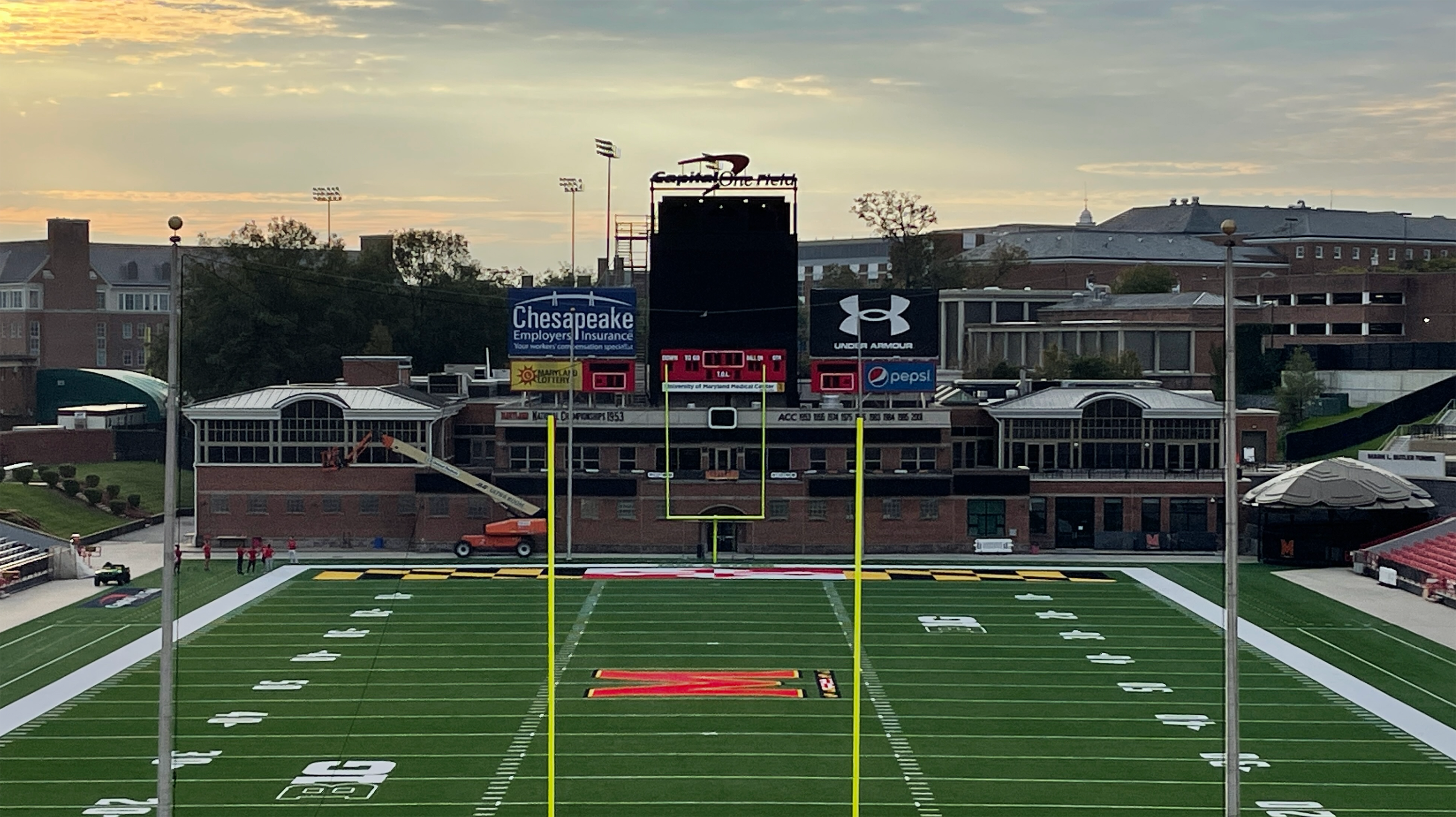University of Maryland Debuts Giant Football Videoboard, Christens Three Control Rooms in Program-Wide Video Upgrade
Daktronics, RCI Systems, multiple vendors are critical to the major facility upgrade
Story Highlights
“Surreal.” It’s the only way to describe when, on that clear Oct. 1 night, TerpVision, the University of Maryland athletic department’s broadcast and production unit, first fired up its brand-new videoboards and sound system at a packed Capital One Field.
The University of Maryland football team was hosting Iowa in a nationally televised game on a Friday night, and fans were getting their first look at the largest videoboard in the Big Ten Conference.
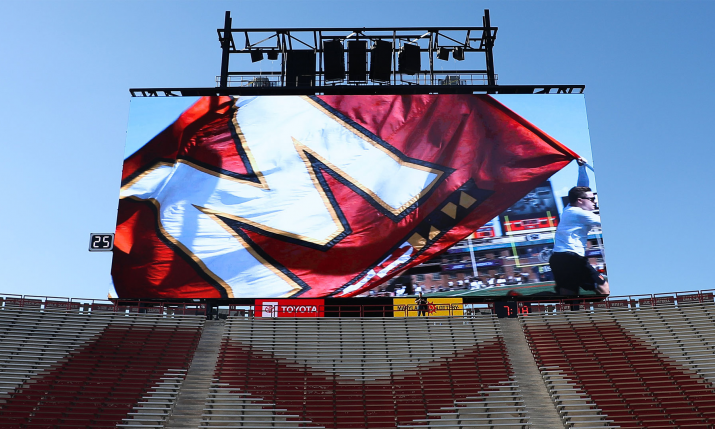
Introduced this month, the University of Maryland’s HDR videoboard at Capital One Field is 6,532 sq. ft., the ninth-largest videoboard in college football and the largest in the Big Ten Conference. (All photos: University of Maryland Athletics)
“It was surreal,” says Josh Clayton, Assistant AD, TerpVision and Video Operations for the University of Maryland. “We started this project more than four years ago and [Athletic Director] Damon [Evans] made it clear that he wanted us to be the best.”
A significant upgrade over its predecessor in both size and image quality, the 120- x 54-ft. (3,600×1,620 pixels) display towers over the west end zone by a whopping 6,532 sq. ft. and projects images in 1080p and high dynamic range (HDR).
In terms of being the best, the Terps are certainly putting their money where their mouth is. The two new videoboards at Capital One Field are just the latest stroke in a multi-year effort to elevate the Maryland Athletics brand.
Over a seven-year stretch, the Terps have redone the centerhung videoboard at XFINITY Center (the school’s basketball arena, which is also used for gymnastics and other major university events), put in connectivity infrastructure at their Field Hockey/Lacrosse Complex and Ludwig Field (men’s and women’s soccer), and are putting the finishing touches on a broadcast-operations center featuring three new control rooms to support in-venue videoboard and live-broadcast operations.
It is here … Enjoy #TerpFam pic.twitter.com/luWtV0KC0e
— Damon Evans (@Evans_TerpsAD) October 1, 2021
Although that big, bright behemoth behind the end zone might be the current conversation-starter, the Terps have set themselves up technologically for the future.
“We took this as, How big can we be? How bright can we get?” says Clayton. “What can we do to instill Maryland Pride in what we’re doing?”
Videoboard Joins a Short List of College Screens With HDR
The big videoboard at Capital One Field takes its place as one of only a handful of college football stadiums to feature videoboards with high dynamic range (HDR). Autzen Stadium at University of Oregon, Ross-Ade Stadium at Purdue, and Bryant-Denny Stadium at the University of Alabama come to mind. Maryland’s also is the ninth-largest in all of college football.
And it’s also not the only new big screen in the building. At the east end of the stadium, TerpVision made a like-for-like swap in size of the videoboard, while upgrading to 1080p HDR. The screen is 34- x 18-ft. and replaces a screen that was nearly 20 years old. Both boards were designed and built by Daktronics and feature a 10-mm pitch and 8,000-nits brightness.
The decision to go HDR wasn’t one that the TerpVision team originally expected to pursue. In fact, four or five years ago, the initial plans considered going 4K. However, with no 4K endpoint deliveries anywhere on the horizon and the steep cost of building a facility of that nature, the group determined that HDR offered a substantial upgrade over current in-venue screens and contributed the flexibility to boost live-broadcast production as well.
It wasn’t without its challenges, however. Not many schools have gone through the process of integrating HDR screens, and there’s a lot of “figure it out as you go” to adopting the format. Clayton notes that locking in the ideal settings was a lengthy process, adding that it took more than 30 hours to perfect the colors on the videoboards prior to their public debut.
As my dad would say I’m his deep New York accent … “It’s YUUUUUUUGE!” #GoTerps 🐢🏈 pic.twitter.com/lLnmGxWtDU
— Jason Yellin (@JasonYellin) October 1, 2021
In addition to the visuals, the school also gave a much-needed upgrade to its audio system, which Clayton acknowledged had drawn the ire of many fans. Crews installed 107 additional speakers in the stadium, including 42 in an array above the big new videoboard. That array includes 16 Fulcrum Acoustic Sub218L direct-radiating subwoofers, 22 JBL VLA301Hi-WRX loudspeakers, three Fulcrum AH463 coaxial horn loudspeakers, and a Fulcrum AH96 coaxial horn loudspeaker.
According to Clayton, the boards and the sound system received rave reviews following that first game on Oct. 1.
“To hear back all of the positive news from the fans was great,” he said following the game. “It really hits you what you just built. It works, and it looks amazing.”
The Mothership: Three Control Rooms Anchor Campus-Wide Effort
The new videoboards may be the eye candy, but they’re only a small piece of the TerpVision program-wide upgrade, which includes the opening of a broadcast-operations center featuring three control rooms within the XFINITY Center.
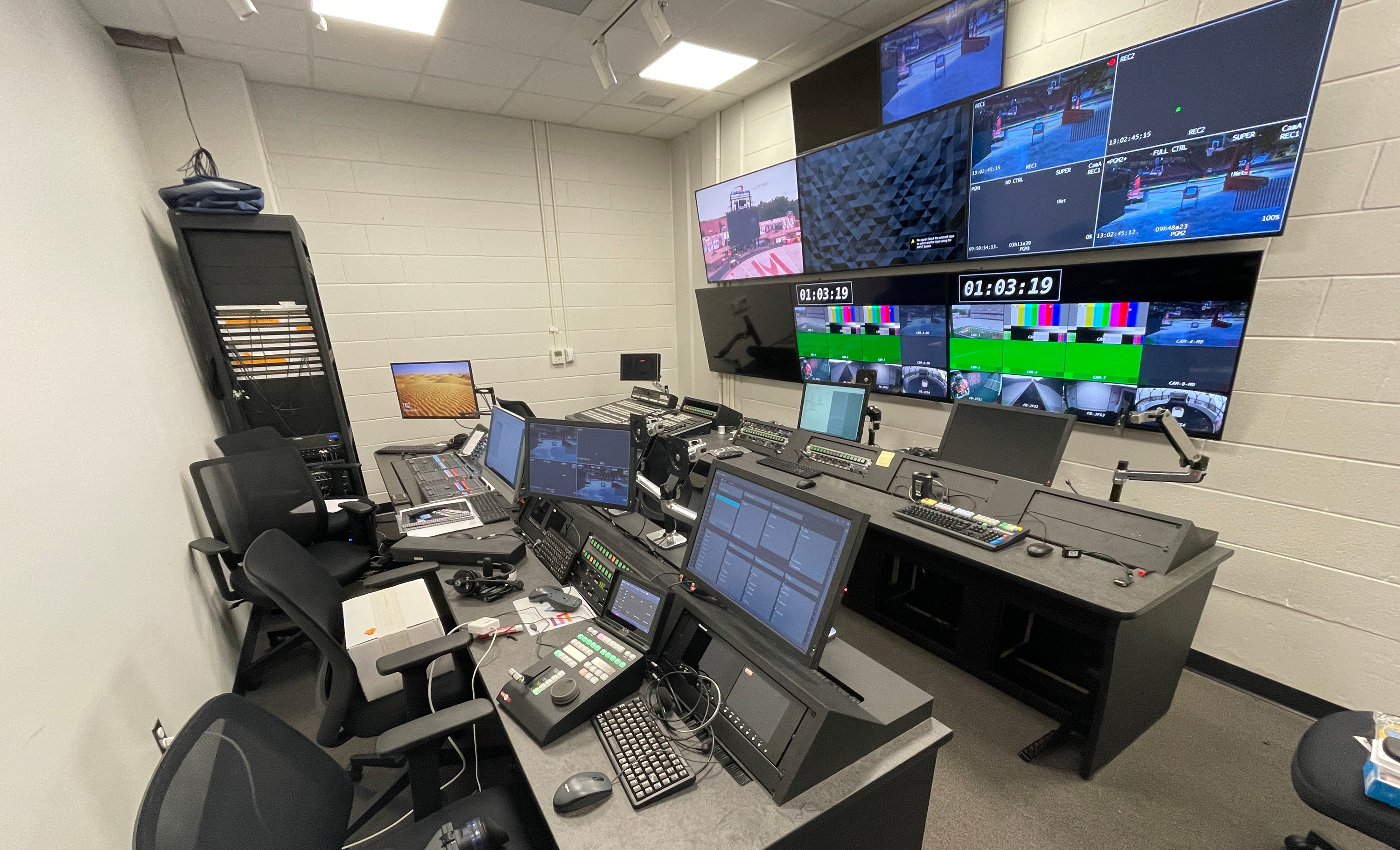
One of two mirrored primary control rooms, which are mostly tasked with supporting in-venue videoboard shows. The control rooms are fibered to five venues on campus, including Capital One Field and the XFINITY Center. Note: At the time of this photo, the room was not yet completed.
Two of them are mirrored control rooms that largely handle in-venue videoboard production at each of the five on-campus venues with big screens: Capital One Field (football), XFINITY Center (basketball, gymnastics, other university events), Ludwig Field (men’s and women’s soccer), Bob “Turtle” Smith Stadium (baseball), and Maryland Softball Stadium. All three control rooms are connected via fiber to those venues.
For the two main control rooms, the department went with a pair of Ross Video Acuity 3 production switchers (60 in, 32 out). For graphics, there are two Ross Xpression units, each with three channels. For replay, there are two EVS XT-VIA’s at 12 channels each (with super-slo-mo), four EVS LSM VIA controllers (a pair in each room), and an EVS X-One to support smaller productions. For comms, the team selected Clear Comm’s Eclipse HX-Delta intercom system, the Freespeak II five-channel wireless intercom solution, and RTS to handle integration with Big Ten Network and other broadcast-production trucks that may visit campus.
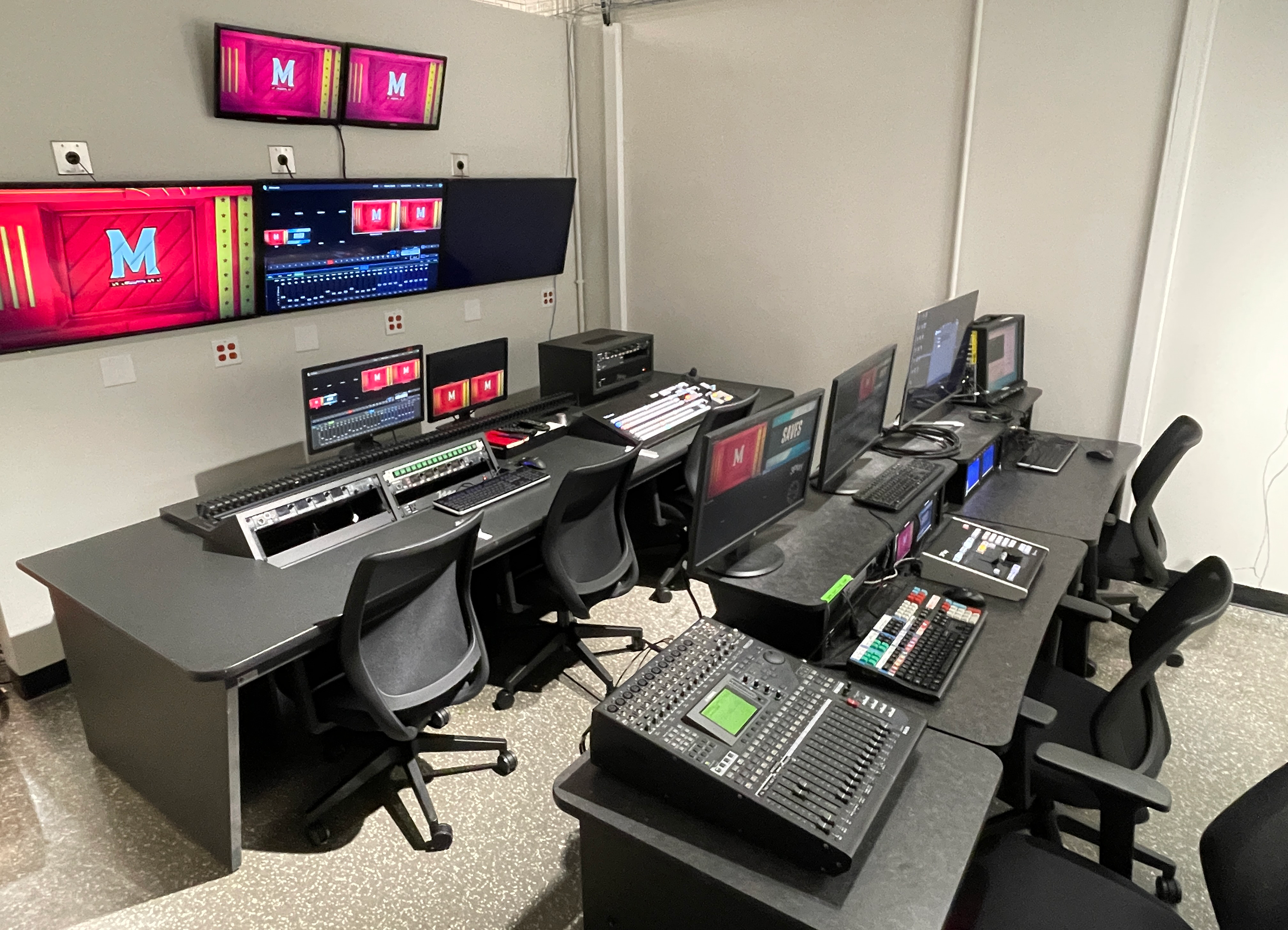
A third control room is dedicated to live broadcast production for B1G+, the Big Ten Network’s live-streaming platform.
The third, smaller control room is dedicated to live broadcasts of Olympic sports that will be streaming on Big Ten Network’s streaming service, B1G+. It is built around the Evertz EQX26 router (380 inputs x 412 outputs), a Magnum server, and Scorpion for 64 channels of Dante.
The B1G+ control room will prove beneficial for Director, Broadcasting/B1G+ Thomas Mason and Assistant Director, Live Productions Aaron Scotch, with the Maryland program called on to produce more live Olympic events internally for the Big Ten Network’s live-streaming platform.
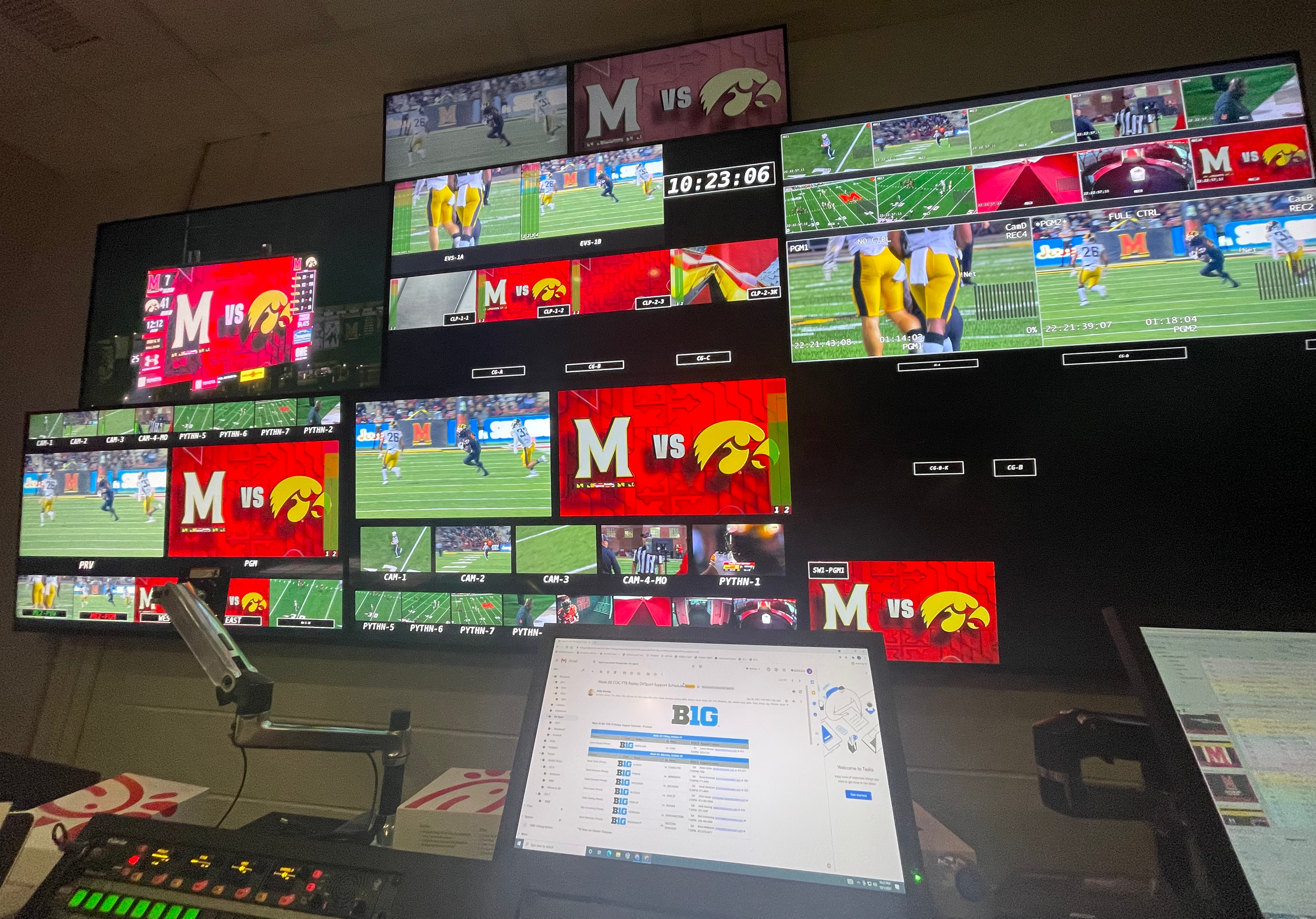
The Control Room 1 monitor wall was first used for a public show when the larger videoboard at Capital One Field debuted during an Oct. 1 football game vs. Iowa.
TerpVision’s camera arsenal also is seriously beefed up. The team invested in eight Sony HDC-3500 cameras (two of which have HFR licenses for 4X super-slo-mo, a pair of Sony BRCX1000 4K PTZs (one affixed to the base of the centerhung videoboard at XFINITY Center and used as the tipoff camera). Also part of the complement are four FUJINON 55X box lenses and eight FUJINON 23×7.6 ENG lenses. According to Clayton, the arsenal is versatile and can be used as studio builds or for big builds with box lenses for live game production.
On the audio front, a slew of Yamaha gear — anchored by the QL-1 FOH digital mixing console — have helped dramatically increase the sound product at the football stadium. A Dante Domain Manager manages all three control rooms, as well as the systems at the football stadium and the XFINITY Center.
“We did our research and were smart about determining what we needed,” says Clayton. “We leant heavily on our relationships with our vendors. They held our hands a lot at the beginning, and that helped us with so many of the little things.”
That external help included key contributions from the teams at Daktronics, RCI Systems (the AV integrators on the project), and Gilbane Construction.
Clayton worked directly alongside Joshua Kaplan, associate AD, facilities, operations, and events on this project, and he credits several others with its success: Associate AS, Broadcasting and Production, Mike Farrell; Senior Associate AD, Internal Operations, Shawn Flynn; Executive Associate Athletic Director/Chief Strategy Officer Brian Ullman; Special Assistant to the Athletic Director Dave Muia; Deputy Athletic Director Colleen Sorem; Athletic Director Damon Evans; and University President Dr. Darryll Pines.
“We’re fortunate with our athletic department in that our AD gave us the charge to do this project and do it big,” says Clayton. “He allowed us to do what we wanted. We had full support across the board, and they believed in us.”
TerpVision is fueled by the contributions of freelancers and students including Jeff Blake, Ed Clark, Jacob Dyke, Kevin McRobie, David Posner, Pat Shannon, John Tillmann, Francine Wyron, Scott Youngblood, and others.
For Clayton, though, no one deserves a bigger thank you than his wife Lauren, who is currently weeks away from giving birth to their third child. Much of this work has overlapped with their pregnancy. Be it at work or at home, Clayton is setting up a pretty strong foundation.
‘We’re set up for the future,” he says. “We are ready.”
